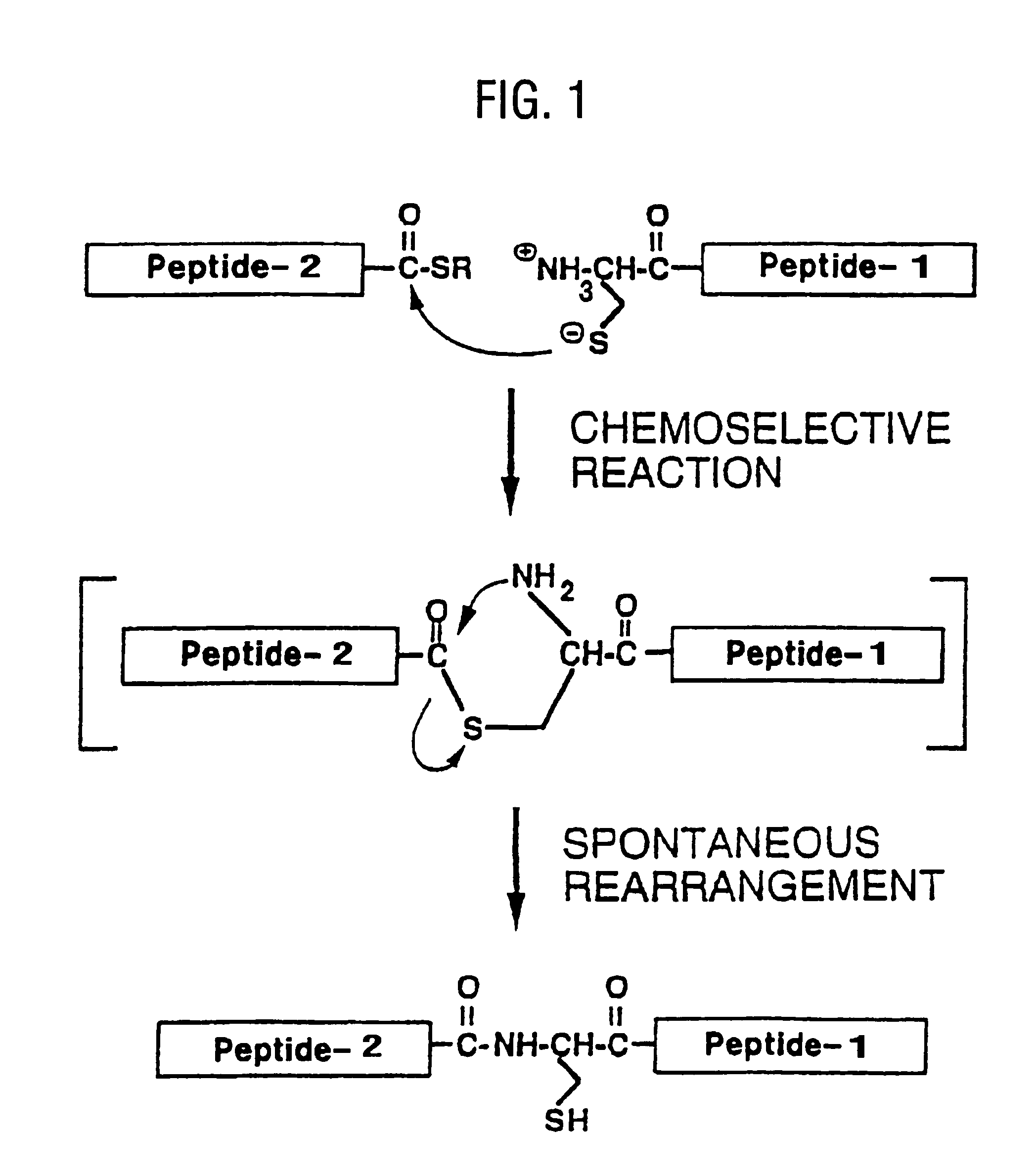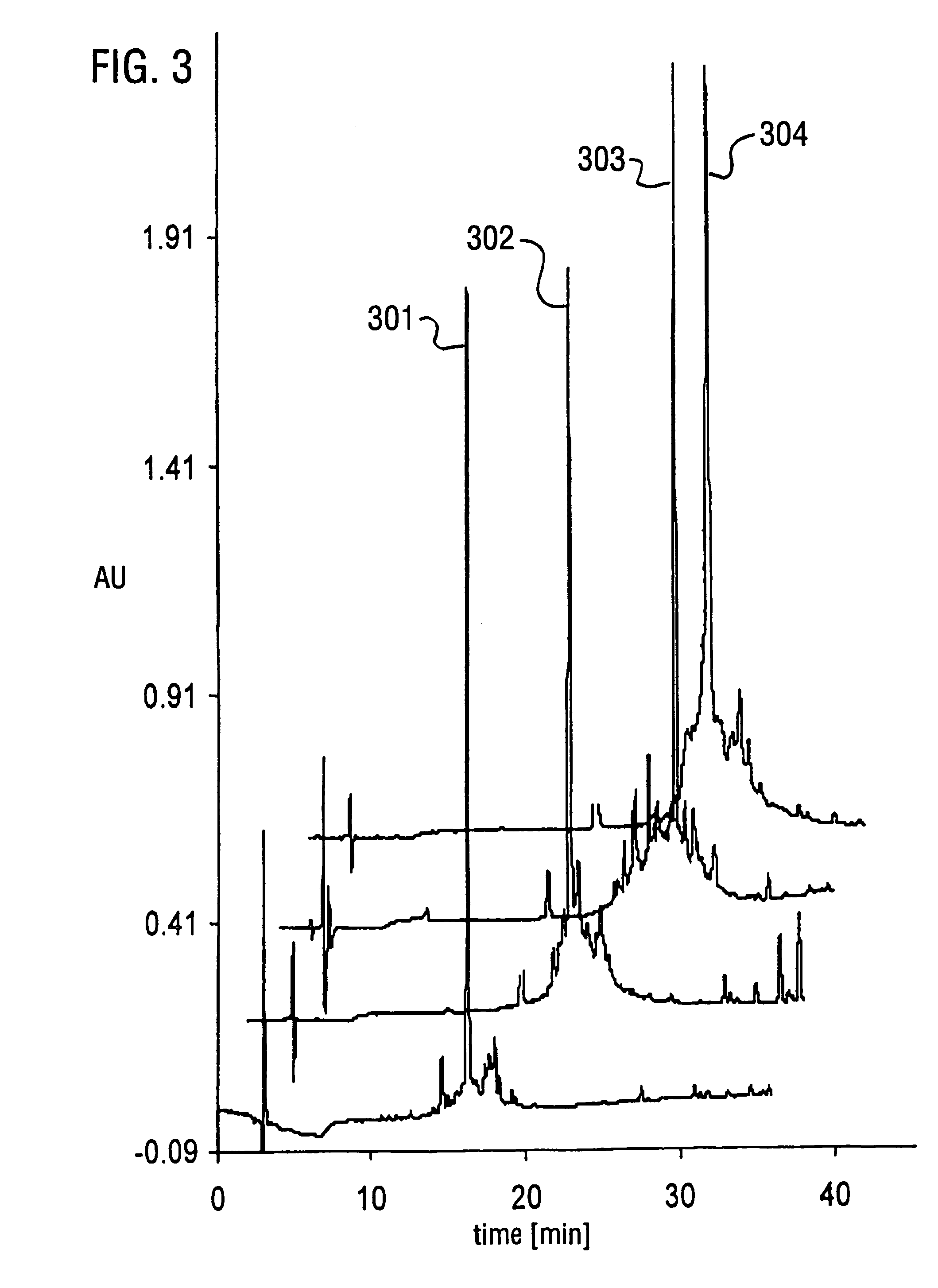Native chemical ligation with three or more components
a chemical ligation and three-or-more technology, applied in the field of polypeptide and protein synthesizing methods, can solve the problems of variability, difficult to predict the presence of a gene that is actually transcribed, and many important hurdles to overcome, so as to improve the efficiency of native chemical ligation reactions
- Summary
- Abstract
- Description
- Claims
- Application Information
AI Technical Summary
Benefits of technology
Problems solved by technology
Method used
Image
Examples
example 1
[0064]In this example, a polypeptide having the sequence of FIG. 2 (SEQ ID NO: 5) was synthesized with the method and materials of the invention. The full length polypeptide was assembled from the previously synthesized oligopeptide intermediates listed below (the superscripted numbers indicate the position of the fragments in the sequence of FIG. 2). Fragment 1 was initially coupled to fragment 2 to give a first product, then after preparative HPLC purification, the first product was coupled to fragment 3 to give a second product. Again, after preparative HPLC purification, the second product was coupled to fragment 4 to give the desired polypeptide, which was purified and refolded.
[0065]
SEQFragmentID NOSequence of Oligopeptide Intermediate11C130AEKSDYIRK INELMPKYAP KAASARTDL15822C82EKLKKKDSQ ICELKYDKQI DLSTVDLKKL RVKELKKILD DWGETCKG12933C40REARGKENR LCYYIGATDD AATKIINEVS KPLAHHIPVE KI8144L1RPGDCEVCI SYLGRFYQDL KDRDVTFSPA TIENELIKF39
[0066]Thioester formation. Fragments 2, 3, 4 were...
example 2
[0075]A polypeptide with the sequence CYAKYAKL (SEQ ID NO: 6) was synthesized using in situ neutralization / 2-(1H-benzotriazol-1yl)-1,1,1,3,3-tetrametyluronium hexafluoro-phosphate (HBTU) activation protocol for stepwise Boc chemistry as previously described (see example 1). The N-terminal cysteine was introduced as Boc-Thioproline, with standard HBTU activation. After Boc removal the peptide was cleaved from the resin by treatment with hydrogen fluoride for 1 hr at 0° with 5% p-cresol as scavenger. The purified final product presented the expected mass of 970.18, consistent with a stable thioproline N-terminal cysteine, confirming the stability of the thioproline ring in the cleavage conditions.
[0076]A series of experiments to determine the optimal conditions for thiazolidine ring opening were conducted at different pH and different O-methylhydroxylamine concentrations. The extent of ring opening was calculated by analytical RP-HPLC. The ring opening induced a net shift in elution t...
PUM
| Property | Measurement | Unit |
|---|---|---|
| pH | aaaaa | aaaaa |
| pH | aaaaa | aaaaa |
| pH | aaaaa | aaaaa |
Abstract
Description
Claims
Application Information
 Login to View More
Login to View More - R&D
- Intellectual Property
- Life Sciences
- Materials
- Tech Scout
- Unparalleled Data Quality
- Higher Quality Content
- 60% Fewer Hallucinations
Browse by: Latest US Patents, China's latest patents, Technical Efficacy Thesaurus, Application Domain, Technology Topic, Popular Technical Reports.
© 2025 PatSnap. All rights reserved.Legal|Privacy policy|Modern Slavery Act Transparency Statement|Sitemap|About US| Contact US: help@patsnap.com



